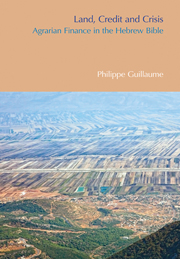Book contents
- Frontmatter
- Contents
- Illustrations
- Acknowledgements
- Introduction
- Part I Land
- 1 Land Tenure
- 2 Communal Land
- 3 The Myth of the Helpless Peasant
- 4 New Perspectives on Land Passages
- Part II Credit
- Part III No Crisis in Yehud
- General Conclusion
- Glossary
- Bibliography
- Index of Biblical References
- Index of Authors
- Index of Subjects
2 - Communal Land
from Part I - Land
- Frontmatter
- Contents
- Illustrations
- Acknowledgements
- Introduction
- Part I Land
- 1 Land Tenure
- 2 Communal Land
- 3 The Myth of the Helpless Peasant
- 4 New Perspectives on Land Passages
- Part II Credit
- Part III No Crisis in Yehud
- General Conclusion
- Glossary
- Bibliography
- Index of Biblical References
- Index of Authors
- Index of Subjects
Summary
Musha‘
Beside the neat categories of Islamic law existed a type of customary tenure that Ottoman and Mandatory authorities sought to abolish by compulsory land registration and consolidation. In Syria, villagers used the term musha‘ to refer to waste-land shared by several villages for grazing (Aswad 1971: 43). The term was first used in reference to a specific type of arable land tenure in the Hauran by the Swiss traveller Johann Ludwig Burckhard (1819: 97–100). Although Elihu Grant (1976: 132) described musha‘ tenure in Palestine without mentioning the name, academic writings now use the term musha‘ to designate communal land allotted temporarily by lottery between shareholders.
The term musha‘ also applies to trees that are held in share ownership, but at this point I focus on the musha‘ that concerns the communal exploitation of arable mīrī land at the village level. The particularity of musha‘ tenure was the attribution of shares of arable land to individual farmers according to two main systems: ‘Open-ended’ and ‘quantified-share’ (Nadan 2003; 2006: 261–98; Adams 1982; Wåhlin 1988; Weulersee 1946: 99–109; Firestone 1990: 92–94; Schaebler 2001; Schloen 2001; Canaan 1916; Klat 1958; Jaussen 1948; Warriner 1975). In the open-ended musha‘, the amount of land received by each unit varied according to non-land factors: the number of males—adult males or married males (dhukūr)—or the number of ploughing teams owned (feddān). In the quantified-share musha‘, only the amount of land was counted, irrespective to changes in the shareholding households.
Shares of musha‘ lands were subject to periodic redistribution, so that a shareholder cultivated plots he had not cultivated in the previous distribution.
- Type
- Chapter
- Information
- Land, Credit and CrisisAgrarian Finance in the Hebrew Bible, pp. 28 - 55Publisher: Acumen PublishingPrint publication year: 2012



